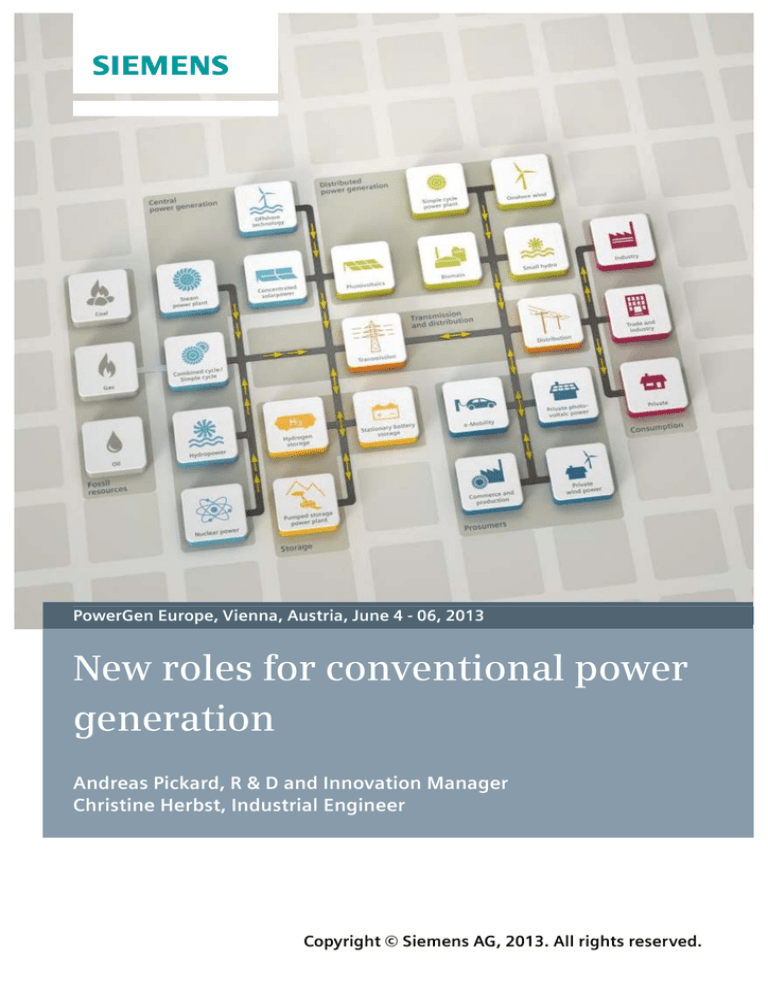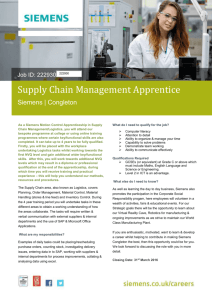
PowerGen Europe, Vienna, Austria, June 4 - 06, 2013
New roles for conventional power
generation
Andreas Pickard, R & D and Innovation Manager
Christine Herbst, Industrial Engineer
Copyright © Siemens AG, 2013. All rights reserved.
PowerGen Europe in Vienna, Austria, June 4 - 6, 2013
Introduction
Cut-throat competition is currently the order of the day in the European energy market as a result of
the energy mix transformation. To drive the transformation forward, renewable energies are receiving
extensive support in some parts of Europe via power levies and guaranteed feed-in payments.
This situation brings changes in operating regimes for existing conventional power plant fleets. Plants
that were still being operated in base load a few years ago are now facing increasingly frequent shutdowns, and in some cases long outage periods. From a purely technical point of view, this has brought
a series of new challenges for power plant suppliers. The first products designed to address these challenges have now emerged onto the market.
At an economic level, the problems are significantly more complex. Business models for conventional
power generation are collapsing as a result of the intensity of the competition. This is a completely
natural process in a free market economy. It should be borne in mind, however, that the economy has a
frequent tendency to head in the wrong direction, the stock market crashes known as “Black Fridays”
being an important example.
Reliable power generation meets a whole series of economic, public health and household needs. Mistakes made in terms of infrastructure maintenance, for example with regard to the expansion of reserve
capacity, are virtually impossible to correct within normal project lifetimes.
Redistributing roles
Germany’s energy mix transformation is comparable to a revolution. New forces – in the shape of
renewable energies – are storming the baseload power supply market. But where does that leave the
“old guard” – conventional power generation capacity? The slew of articles about possible power plant
shutdowns give the impression that it simply isn’t needed any more.
Before pulling out of conventional power generation, however, we should consider whether we can
really afford to do so. This requires us to take a look at the weak points of renewable energies. No
great capacity expansion is expected for hydro power and biomass. This leaves wind and solar power
generation as the leading renewables. Both of these energy sources are strongly dependent on the
weather. In fact, they are sometimes referred to as “fluctuating energy sources”.
Our current infrastructure was developed for a power supply model based around daily fluctuations in
consumption. Supply-side fluctuations were considered only as a disturbance variable, and not as a
Copyright © Siemens AG 2013. All rights reserved.
2
PowerGen Europe in Vienna, Austria, June 4 - 6, 2013
weather-related phenomenon. Baseload (i.e. continuous) requirements were met mainly by nuclear and
coal-fired power plants. Intermediate load requirements during the day were covered by, among other
things, gas-fired plants. The daily load peaks were covered by peak-load plants such as pumped storage and gas-turbine power plants.
Fluctuating renewable energy sources are now making inroads into baseload capacity, thereby forcing
out conventional plants. The latter are still needed, however, to compensate for weather-induced loss
of renewable generating capacity. This means that conventional plants now supply power on demand.
The fluctuation in supply from renewable sources means that demand for continuous baseload power
is continuously falling. Intermediate load demand is undergoing a similar trend, while peak load demand (measured over a period of less than four hours) is continuously increasing. As a consequence,
highly-efficient plants are being displaced from baseload to intermediate load capacity, and are in turn
displacing less efficient plants from intermediate load to peak load capacity. The reserve capacity covered by conventional sources remains virtually constant for the time being, since only 5% of the installed capacity of fluctuating power sources can be considered as guaranteed capacity.
There is a further gap that has to be covered by conventional power plant types. The expansion of
weather-dependent power generation has led to an increase in forecast error on the supply side, leading
in turn to a rise in demand for control reserve capacity. However, guaranteed control reserve capacity
can only be offered by plants that also have a guaranteed power reserve. According to the literature 1 ,
approximately 16 GW (equivalent to around 20% of maximum demand) of Germany’s conventional
capacity has to be operated in base load for the purpose of grid frequency control.
The energy mix transformation is designed to ensure that power is generated as sustainably as possible. The displacement of conventional power from baseload capacity does indeed reduce fuel consumption and CO2 emissions. However, electricity is almost impossible to store, so that any imbalance between supply and demand automatically destabilizes the transmission network. To prevent this
from happening, conventional power generation is required to ensure security of supply by providing
grid services such as supply on demand, frequency stabilization and frequency reserve. In summary,
what is needed is a redistribution of roles. It is time to fight against the trend of existing plants being
displaced from the market by fluctuating energy sources. In addition, following the nuclear phase-out
decision, we still have to provide new-build capacity to replace the nuclear plants that are scheduled to
be shut down.
1
Institut für elektrische Anlagen und Energiewirtschaft (IAEW), Consentec GmbH: Study to determine the technical minimum generation from conventional power plants required to guarantee system stability in German transmission networks,
especially in situations with high renewables generation, Jan 20th 2012 (Studie zu Ermittlung der technischen Mindesterzeugung des konventionellen Kraftwerkparks zur Gewährleistung der Systemstabilität in den deutschen Übertragungsnetzen bei
hoher Einspeisung aus erneuerbaren Energien 20 Jan. 2012)
Copyright © Siemens AG 2013. All rights reserved.
3
PowerGen Europe in Vienna, Austria, June 4 - 6, 2013
Security of supply: the basis of a new business model
Fierce competition normally leads to significant price erosion. This trend is also evident in the power
generation market, where it is further boosted by the low marginal costs of wind and photovoltaic
power plants, which have zero fuel costs. In addition, the legally guaranteed feed-in payment protects
investments against price dumping. A significant downturn in production, and hence in revenues, is a
natural consequence of displacement from power generation markets. As a result, fixed plant costs are
spread over a lower output, while plant productivity falls. This phenomenon is known in the literature
as the “missing money problem”.
Fuel cost
Capital cost
Leverage
Investment
CO2 Certificates
Service, Insurance & operation
Revenue
Capitalized Value
Figure 1:
Economic efficiency calculation for a intermediate load power plant, based on typical business models
The implementation of legislation on the withdrawal from nuclear energy is likely to result in a shortage of power generation capacity and hence a rise in electricity prices. However, if this increase in
price and operating hours is considered, there is still no positive goodwill for a new power plant (as
shown in Figure 1). Investors therefore have two options.
The simpler option is not to invest. Alternatively, further business opportunities can be considered. As
the foregoing has shown, security of supply offers additional commercial potential. However, security
of supply is not treated as a commodity. Instead, a series of products can be proposed to the market.
For example, various supply-on-demand products are traded, to meet gaps in demand for power supply, while frequency stabilization markets also provide opportunities.
In respect of supply on demand, a distinction can be made between base load (continuous operation
for more than one week) intermediate load (continuous operation for more than four hours) and peak
load. Base load can be ruled out, since this operating mode will only be required to guarantee frequency control, and not to meet power demand. Intermediate load offers potential for 2,000 to 4,000
Copyright © Siemens AG 2013. All rights reserved.
4
PowerGen Europe in Vienna, Austria, June 4 - 6, 2013
hours of plant operation, if the predictions of the VDE scenario are correct. Between 200 and 300
startups and shutdowns should be taken into consideration, depending on the residual load band to be
met. During periods of strong wind, plant downtimes may last for several days (as an initial approximation, 25 downtime periods lasting longer than two days should be taken into consideration). Up to
1,800 hours of peak load operation are possible. Operating under every possible peak load opportunity
would involve covering up to 700 events, in which case the plant would never be out of operation for
longer than two days. In reality, it has to be assumed that part of peak load demand will be met by the
spinning reserve. This reduces the available operating hours to below 1,200. In this case, the number
of startups is halved. In addition, at least 25 downtime periods lasting longer than two days should be
taken into account.
With regard to frequency support products, a distinction is made between frequency control, which
involves continuous operation, and control reserves that could theoretically be offered from the shutdown condition. With currently available solutions, thermal plants can, at most, provide the tertiary
control reserve from shutdown, since the response time from that condition is not sufficient to meet
the grid code requirements for the secondary reserve.
The opportunity matrix for the future business model is shown in Figure 2 below.
Operating
regime
Base load
Mid-load
Peak load
In spinning
operation
Unlikely
Opportunity
Frequency control
(primary)
Secondary
Business target
Opportunity
Tertiary
Peak load
Figure 2:
Opportunity
Opportunity
Business target
Opportunity matrix for security-of-supply business model
This business approach significantly increases the profitability of future investments. Figure 3 (which
shows the profitability calculation according to the new business model) clearly illustrates that control
Copyright © Siemens AG 2013. All rights reserved.
5
PowerGen Europe in Vienna, Austria, June 4 - 6, 2013
reserve capacity and peak load, in particular, contribute to a significant improvement in the revenue
situation.
Revenue Peak Load
Revenue Grid Support
Income Tax
Fuel cost
Capital cost
Leverage
Investment
CO2 Certificates
Service, Insurance & operation
Revenue Power Generation
Capitalized Value
Figure 3:
Economic efficiency calculation for a intermediate load power plant, based on the new business
model
The economic efficiency analyses are based on the predicted operating hours for a highly-efficient
gas-fired intermediate load power plant. Up to time of the nuclear shutdown, an operating regime of
less than 2,000 hours is considered. From 2022, when the last nuclear power plants in Germany will be
shut down, demand will rise to almost 4,000 hours. It is assumed that revenues from electricity will
fall again in the long term without peak-load operation. This scenario does not take account of energy
storage via a power-to-gas concept. If that were taken into consideration, this approach would be considered overly pessimistic.
Business model requires new solutions
Existing plants are already moving quietly toward the emerging business opportunities. In order to
maximize economic value, however, the technical solution has to be optimized to the new business
approach. Key success factors are market presence, the ability to start up at short notice, and the ability
to load-follow. At the same time, the basic plant concept must be designed such that the marginal return is maximized. This makes efficiency increasingly significant, since it has a decisive influence –
via fuel costs – on marginal costs. It should be stressed that this is not about optimizing design efficiency. The issue here is optimizing the average efficiency over a twelve-month period in light of the
energy mix transformation. This encompasses startups and shutdowns, as well as operating load
points.
SCC5-8000H: the basis of the new business model
Copyright © Siemens AG 2013. All rights reserved.
6
PowerGen Europe in Vienna, Austria, June 4 - 6, 2013
Since efficiency plays a key role in optimizing margin, a power plant concept based on an H-class gas
turbine was developed for the purpose of the analyses. This technology allows an efficiency improvement of more than 1.5% over the entire load range compared with the established F-class gas turbine
(see Figure 4 below).
CC Gross Efficiency
∆ Eff. = ~1.5%-Points
SCC5-8000H 1S
SCC5-4000F 1S
50
60
70
80
90
100
CC Re. Power (%)
Figure 4:
Efficiency comparison between F-class and H-class
Further improvements in efficiency were achieved by optimizing startups and shutdowns. The efficiency of these transient processes can be improved by the use of FACY technology. For example, an
efficiency benefit of around 14% can be achieved for a hot startup after an 8-hour shutdown, compared with a conventional startup. The use of FACY technology considerably shortens the startup
process, while simultaneously using the initial steam to generate power, rather than dumping it.
FACY technology
FACY technology has enabled Siemens to considerably reduce plant startup and shutdown processes.
Up to a few years ago, a startup time of around one hour was required after a shutdown of a few hours.
A similar improvement has been delivered in terms of shutdown times; in the past, around one hour
was generally required to transition the plant to turning gear operation. It was felt at that time that any
reduction in startup or shutdown time automatically had a negative effect on residual lifetimes. Siemens has demonstrated through the use of FACY technology that both startup and shutdown times can
Copyright © Siemens AG 2013. All rights reserved.
7
PowerGen Europe in Vienna, Austria, June 4 - 6, 2013
be halved by applying a new concept, without negatively impacting the residual lifetime of plant components.
Given the number of publications available on FACY technology, this article will refrain from describing its principles. However, Figure 5 shows the validation runs carried out with the FACY technology at the Ulrich Hartmann plant in Irsching, Germany.
600
60
Plant Start up Time < 30 min.
CC Full Load
500
Plant Output
Plant Output
400
40
Ø Ramp Rate > 25 MW/min
GT Speed
ST Speed
300
30
200
20
Turbine Speed
50
GT Load
up to 35 MW/min
100
10
0
0
GT ignition
GT @ base load
Time [min]
Figure 5: Startup validation runs (cooldown time >8 hours) at Ulrich Hartmann
Dispatch+: reducing startup times after long plant outage periods
As has already been indicated, plant downtimes will increase in future. As a result, plants may cool
down to such an extent that an acceptable startup time – with current concepts – is no longer possible.
It is expected that dispatch rates can be significantly increased if startup times could continue to be
kept under 60 minutes in such cases. Siemens has developed the Dispatch+ system, based on a heating
concept, which restricts plant cooldown such that startup times of less than 60 minutes can still be
achieved even after an outage time of one week.
Initial studies show that use of the system enables startup time to be reduced by around 40 minutes
after an outage of 48 hours, thereby increasing efficiency.
Copyright © Siemens AG 2013. All rights reserved.
8
PowerGen Europe in Vienna, Austria, June 4 - 6, 2013
The renaissance of auxiliary firing
A number of power plants in the USA are equipped with auxiliary firing to bring additional peak load
revenues for operators. In Europe, this solution has unjustly fallen into disrepute. Poor operational
efficiency is primarily cited as an argument against it. From a thermal-dynamic point of view, the
power generated by auxiliary firing is produced at a significantly lower efficiency level, since the gas
is converted into power with the secondary system only. It should be borne in mind that this operating
mode is only used when the grid requires support. Under such conditions, a higher peak load price can
be charged for the additional power generated using the system (as shown in the new business model).
When designing the system, care must be taken to ensure that the capacity reserve is not too large. As
a rule of thumb, capacity increases of around 10% can be achieved with virtually no impact on efficiency. If this reserve is significantly exceeded, the oversizing of the steam turbine in terms of its
swallowing capacity inevitably leads to a negative impact on plant efficiency under both design and
part-load operating conditions.
A market poisoned by uncertainty
Unfortunately, presenting a business model together with the associated power plant concepts, as has
been done in this paper, is not sufficient to generate the necessary investments. Instead, there is a risk
that site closures in the short-term and an absence of investments could lead to a dangerous shortfall in
terms of security of supply.
In general, electricity is a product that has to be consumed immediately. This means that electricity
generating capacity has to precisely match demand. Minor discrepancies between supply and demand
are compensated using control reserve capacity. Major deviations, however, lead to destabilization of
the power supply. Such deviations could occur if the existing infrastructure is no longer adequate to
reliably assure the balance between generating capacity and demand.
In contrast to the short-term electricity market, additional infrastructure can generally only be constructed on a long-term basis. At least four years are required, for example, to build a new power plant.
Today’s competition-based market is sending out a signal, via currently falling prices, that it is not
worth investing. In addition, there is a general uncertainty caused partly by the revolution in the market, and partly by apparently unpredictable political intervention. As a result, investment risk is increased, at a time when yield expectations are moderate. This kind of climate does not encourage investment in the electricity market.
Copyright © Siemens AG 2013. All rights reserved.
9
PowerGen Europe in Vienna, Austria, June 4 - 6, 2013
Sticking to the nuclear phaseout decision means this development would be disastrous for Germany,
since a critical shortage of capacity will occur from 2022 (see Figure 6). The Figure shows the country’s currently predicted new-build requirement. It can be seen that around 12-17 GW of capacity will
be required to replace plants removed from service.
nuclear
phaseout
power plant
decommissioning*
total decline
of flexible
capacities
*mainly coal-fired power plant
Source: Siemens AG, federal network agency
fixed
capacities
due to
renewables
reduction of
power
reserve
flexible
capacities
under
construction*
gap 2022
Figure 6: New-build requirement in Germany
It is, of course, very easy to point the finger at politicians, instead of getting on with developing solutions. In this case, however, it is hard to avoid doing just that, since, while solutions in terms of business models are already available, both the cause of the uncertainty and its antidote are in the hands of
politicians. Subsidy laws are repeatedly amended, for example, and the market made increasingly socialist, without distributing responsibility for security of supply. These problems must be resolved by
creating solutions designed to make the system more secure.
Market designs currently being discussed range from capacity markets to the responsibility mechanism
for safe feed-in. The author is happy to leave the decision on which option is the right one to politicians and economists. Everyone should be aware, however, that a market cannot be transformed in the
short term. It is therefore strongly recommended that transitional instruments be put in place to prevent
infrastructure and security of supply from being degraded. In addition to the economic consequences,
our electricity supply system is also important for social order and public health. It is certainly not in
our society’s best interests to play with its future.
Copyright © Siemens AG 2013. All rights reserved.
10
PowerGen Europe in Vienna, Austria, June 4 - 6, 2013
Conclusion
Politicians, driven by climate protection objectives, have decided on the need to transform our energy
mix. Programs have therefore been put in place to promote CO2-neutral power generation. This has
had the intended effect of continuously increasing Germany’s installed base of fluctuating power generation capacity based on wind and solar power. These energy sources are steadily displacing conventional power generation capacity from its previous role in somewhat revolutionary fashion. However,
this does not mean that we no longer require conventional energy sources; they have to continue to
make up for the shortfall whenever fluctuating power sources are unable to provide sufficient capacity
due to weather conditions. In addition, demand for control reserve capacity is increasing, since
weather-dependent power generation has a higher forecast error than fossil-fired power. Conventional
power generation therefore takes on the key role in terms of security of supply in the energy market. If
these aspects are taken into consideration an in economic value analysis for a new-build fossil-fired
power plant, a positive return can certainly be achieved that would not be possible with the previous
business model based purely on power generation.
To maximize the economic value of a power plant, Siemens can now offer a series of solutions tailored to meet the needs of future market segments. Auxiliary firing, for example, can provide capacity
on demand for the peak load range. FACY technology enables rapid plant startup and shutdown in the
intermediate load range, while Dispatch+ maintains plants ready for operation for up to several days,
and allows startup times comparable to hot starts.
Unfortunately, revamped business models and power plant solutions optimized to the future load regime are not sufficient to generate the necessary investments. Instead, the power generation market is
so beset by uncertainty that short- and medium-term solutions at a political level are required to protect investors against further disturbances and uncertainties.
Copyright © Siemens AG 2013. All rights reserved.
11
PowerGen Europe in Vienna, Austria, June 4 - 6, 2013
Permission for use
The content of this paper is copyrighted by Siemens and is licensed to PowerGen Europe for publication and distribution only. Any inquiries regarding permission to use the content of this paper, in
whole or in part, for any purpose must be addressed to Siemens directly.
Disclaimer
These documents contain forward-looking statements and information – that is, statements related to
future, not past, events. These statements may be identified either orally or in writing by words as
“expects”, “anticipates”, “intends”, “plans”, “believes”, “seeks”, “estimates”, “will” or words of similar meaning. Such statements are based on our current expectations and certain assumptions, and are,
therefore, subject to certain risks and uncertainties. A variety of factors, many of which are beyond
Siemens’ control, affect its operations, performance, business strategy and results and could cause the
actual results, performance or achievements of Siemens worldwide to be materially different from any
future results, performance or achievements that may be expressed or implied by such forward-looking
statements. For us, particular uncertainties arise, among others, from changes in general economic and
business conditions, changes in currency exchange rates and interest rates, introduction of competing
products or technologies by other companies, lack of acceptance of new products or services by customers targeted by Siemens worldwide, changes in business strategy and various other factors. More
detailed information about certain of these factors is contained in Siemens’ filings with the SEC,
which are available on the Siemens website, www.siemens.com and on the SEC’s website,
www.sec.gov. Should one or more of these risks or uncertainties materialize, or should underlying
assumptions prove incorrect, actual results may vary materially from those described in the relevant
forward-looking statement as anticipated, believed, estimated, expected, intended, planned or projected. Siemens does not intend or assume any obligation to update or revise these forward-looking
statements in light of developments which differ from those anticipated.
Trademarks mentioned in these documents are the property of Siemens AG, its affiliates or their respective owners.
Copyright © Siemens AG 2013. All rights reserved.
12







